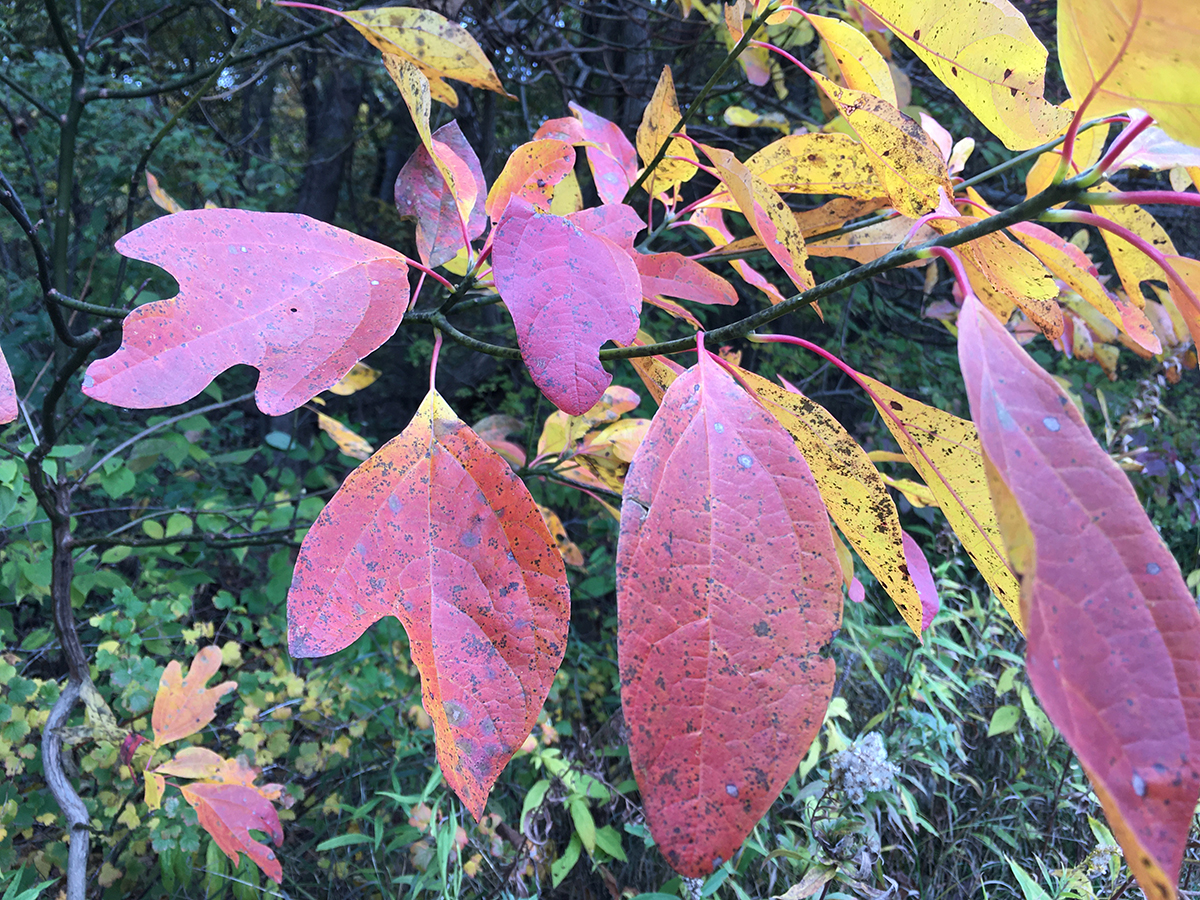Fall color has definitely been spectacular this year along the bluffs of the Illinois River. There is really never a year that has dreadful fall color. It is just some years stand out from others. This year, we had consistent rain through the summer, which always helps the trees. We also had a long stretch of October weather with sunny days, cool nights, which helps the colors pop against the brilliant blue sky. Early winds and storms didn’t strip our trees of leaves prematurely, and we were able to hit peak colors around mid-month.
One of the first trees to put on a blush of fall color is often overlooked by the leaf-peepers that frequent the forest in October. The Sassafras (Sassafras albidum) is a medium sized tree that tends to grow at the edge of woodlands or in savanna habitat. It is a lover of sunlight, and openings. Peoria is kind of at its northern range. Around here, it grows to be around 35 feet tall and up to a foot in diameter. There are a few larger specimens in Peoria. One in the Springdale Cemetery Savanna Natural Area near the Cole monument, and another is directly behind the A-frame building of Forest Park Nature Center. In early October, the Sassafras leaves start to turn color. Shades of yellow, plumb, orange and red will sometimes be all found together on one tree. It is not only the color of the leaves that can be diverse, but the shape of the leaves themselves are varied. Some leaves are simply oval in shape, while others look like a mitten with a thumb, still others will look like a mitten with two thumbs.
Sassafras is a member of the Laurel family of plants. It is a close relative to such plants as aromatic cinnamon, camphor, sweet bay, true laurel, and spicebush. As you might guess, the Laurel family is full of plants that have volatile oils that are highly aromatic. Our native Sassafras is no different, and it has often been used as a flavoring of foods, tees and tonics. Its aroma has been described as a “root beer” smell. In early European settler times, its roots were sought after as an export product, where it was touted by the English as a “wonder drug.” Settlers in Jamestown in the early 1600s were required to supply 100 pounds of Sassafras root for export or pay a penalty of 10 pounds of tobacco. It never really lived up to its medicinal hype, though, and lost favor as an export item, although it still was popular as a flavoring.
The aromatic oils that produce the flavors are comprised mainly of a cyclical chemical called safrole, which makes up about 80% of oil of Sassafras. The oil concentration is highest in the roots of the tree, which made ground roots the key ingredient to Sassafras Tea. Safrole was synthetically produced as a flavoring as well, and found commercially in root beer until the early 1960s. At that time, it was found that safrole, and its metabolites, were carcinogenic, and could lead to liver cancer. So today the roots are no longer commercially used as a flavoring. However, the leaves of Sassafras do not contain high concentration of safrole, and are still used as a flavoring. Dried, ground, and sifted Sassafras leaves are the main ingredient in the Cajun seasoning known as File powder.
Beyond its aromatic qualities, Sassafras is also an important food plant for the caterpillars of both Tiger and Spicebush Swallowtail butterflies along with several species of moths. The flowers are early bloomers and are cross-pollinated by several species of small, native bees and flies. Numerous birds, including Eastern Bluebird, Eastern Towhee and Bobwhite Quail, are attracted to the fleshy seeds that form in the summer.
By the time the oaks, maples, and other forest trees are putting on a colorful show, the Sassafras has dropped its leaves and quietly goes dormant. It is as if this small tree that grows on the edge of the forest has decided not to compete with the giants, but is more content with playing a role as an opening act for the spectacle of color that comes our way every autumn. Make sure you take time in early autumn to catch the show this tree contributes to nature’s palette. It is a harbinger of what is to come. If the Sassafras is colorful in early October, the rest of the autumn will shape up to be great as well.



2 comments for “Nature Rambles | Stage set for sassy scenery: Sassafras leaves harbinger for spectacular fall”